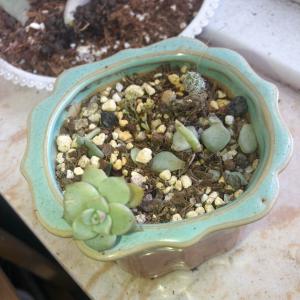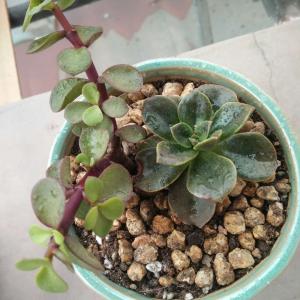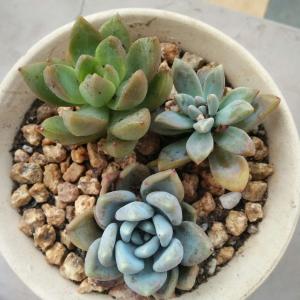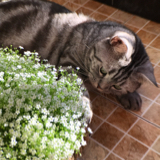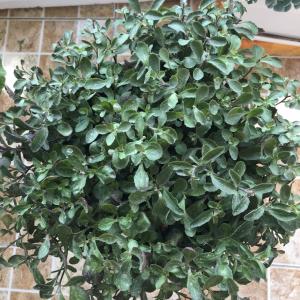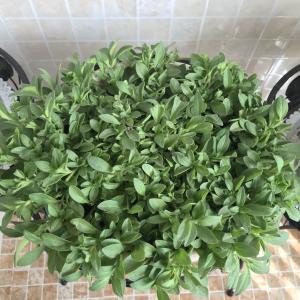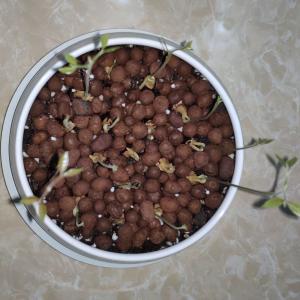文章
Miss Chen
2018年05月06日

Description: This perennial herbaceous plant is 2–4' tall. The central stem is light green, bluntly 4-angled with shallow channels along its sides, and usually unbranched. This stem is hairless to moderately short-pubescent. Pairs of opposite leaves occur along the entire length of the stem. These leaves are 2–6" long, 1½–4" across, usually ovate in shape, and coarsely serrate-crenate along their margins. The leaf tips are usually acute, while the leaf bases are wedge-shaped (cuneate) to rounded. The upper leaf surface is medium to dark green and hairless to sparsely short-pubescent, while the lower leaf surface is light grayish green, hairless to sparsely pubescent, and glandular-punctate (appearing like glistening dots in bright light). The narrow petioles are ½–2" long, light green, and hairless to moderately short-pubescent; sometimes the uppermost leaves are sessile or nearly so. The central stem terminates in either a spike-like raceme or pyramidal panicle of flowers (depending on the robustness of individual plants). Individual panicles are up to 8" long and 6" across, consisting of a central stalk and several lateral branches that become progressively shorter upward. These lateral branches are spreading to ascending. Both the central stalk and lateral branches of the inflorescence are light green and bluntly 4-angled with shallow channels along their sides; they are hairless to moderately short-pubescent. The inflorescence also has small green bracts that are less than 1/8" (3 mm.) long; they are narrow in shape and early-deciduous.
Individual flowers are about 1/3–1/2" (8–13 mm.) long, consisting of a short-tubular to bell-shaped green calyx with 5 teeth, a two-lipped tubular corolla that is predominately cream-colored or yellow, 2 long-exserted fertile stamens, and an ovary with a slender style that is also long-exserted. The calyx is minutely pubescent and glandular-punctate; it has 2 linear-lanceolate lower teeth and 3 linear-deltate upper teeth; the lower teeth are longer than the upper teeth. The calyx also has 10 narrow longitudinal ridges that are dark green. The corolla has a narrow tubular base, but it becomes wider and more trumpet-shaped towards its mouth with 5 spreading lobes (2 upper lobes, 2 lateral lobes, and 1 lower lobe that is larger in size). The upper and lateral lobes are either oval or oval-deltate in shape, while the lower lobe is violin-shaped, mostly white, and heavily fringed along its outer lip. Sometimes there are reddish stripes or bars along the upper and middle lobes of the corolla, while either patches or stripes of faded red may occur toward the base of the lower lobe. The throat of the corolla is a little wider than tall, where there is a patch of fine white hairs. The filaments of the stamens are white, light yellow, or light greenish yellow, while the fertile anthers are either white or light yellow. The slender style is dark red and usually bent toward one of the stamens. The pedicels of the flowers are about 1/8" (3 mm.) in length or slightly longer; they are light green and short-pubescent.

The blooming period occurs from mid-summer to early autumn, lasting about 3-4 weeks. Both the flowers and foliage have a lemon or citronella scent. Afterwards, the flowers are replaced by small nutlets (0-2 nutlets per flower); they develop within enlarged calyces. Individual nutlets are about 1.5 mm. across, globoid but somewhat flattened in shape, and dark brown. The root system consists of hard woody rhizomes with coarse fibrous roots. This plant often forms clonal colonies from its rhizomes.
Cultivation: The preference is medium to light shade, mesic conditions, and mildly acidic soil containing humus and loam. This plant is an excellent choice for a shade garden under deciduous trees.
Range & Habitat: Richweed (Collinsonia canadensis) is uncommon in east-central Illinois and southern Illinois, where this plant is native, while in the rest of the state it is absent (see Distribution Map). Illinois lies along its western-range limit; Richweed is more common further to the east. Habitats include rich woodlands, rocky upland woodlands, wooded areas in rocky river valleys, and less often elevated areas in swamps. This plant tends to occur in oak-hickory woodlands and beech-maple woodlands, especially in areas where sandstone bedrock is not far from the ground surface.

Faunal Associations: Bumblebees are the primary pollinators of the flowers, where both nectar and pollen are available as floral rewards (Skinner, 1976). Several species of insects are known to feed on Richweed (Collinsonia canadensis); many of these species are monophagous or oligophagous. These insect feeders include larvae of the gall flies, Dasineura collinsoniae and Lasioptera collinsonifolia, such aphids as Hyalomyzus collinsoniae and Hyalomyzus eriobotryae, Amblycorypha rotundifolia (Round-winged Katydid), and the larvae of such Noctuid moths as Psectrotarsia herbardi (Horse-balm Sun Moth), Papaipema astuta (Yellow Stoneroot Borer Moth), Papaipema duplicatus (Dark Stoneroot Borer Moth), and Papaipema nebris (Stalk Borer Moth); see Felt (1917), Blackman & Eastop (2013), Gangwere (1961), and Natural History Museum (2010). Slugs also feed on the flowers of Richweed (personal observation, 2017). Among vertebrate animals, the seeds of this plant are eaten by the Bobwhite Quail and possibly other birds (Miller & Miller, 1999). White-tailed Deer and other mammalian herbivores usually avoid this plant as a food source.
Photographic Location: A rocky woodland at the Pine Hills State Nature Preserve in west-central Indiana.

Comments: This wildflower produces flowers in late summer when there is little else in bloom in shady woodlands. While bumblebees have been reported to be the primary pollinators of the flowers (Skinner, 1976), the long-exserted stamens and styles of the flowers, the white fringe of the lower lip of the corolla, and the fragrance of the flowers suggest that moths also visit the flowers for nectar. When the flowers of Richweed (Collinsonia canadensis) are in bloom, this plant is fairly easy to identify because of their distinctive appearance. Otherwise, it may be difficult to distinguish this species from other plant species that grow in woodlands, such as Scrophularia (Figwort) and Agastache (Giant Hyssop). A non-native species that is becoming invasive in wooded areas, the green-leaved form of Perilla frutescens (Beefsteak Plant), could also be confused with Richweed on the basis of its foliage. However, the flowers of the Beefsteak Plant do not have a deeply fringed lower lip nor do they have strongly exserted stamens and styles. The lemon-citronella fragrance of the foliage of Richweed, however, can be used to distinguish it from these other plants. While there are several similar-appearing Collinsonia spp. in southeastern USA, none of them occur in Illinois. Other common names of Collinsonia canadensis include Stone Root and Northern Horse Balm.
Individual flowers are about 1/3–1/2" (8–13 mm.) long, consisting of a short-tubular to bell-shaped green calyx with 5 teeth, a two-lipped tubular corolla that is predominately cream-colored or yellow, 2 long-exserted fertile stamens, and an ovary with a slender style that is also long-exserted. The calyx is minutely pubescent and glandular-punctate; it has 2 linear-lanceolate lower teeth and 3 linear-deltate upper teeth; the lower teeth are longer than the upper teeth. The calyx also has 10 narrow longitudinal ridges that are dark green. The corolla has a narrow tubular base, but it becomes wider and more trumpet-shaped towards its mouth with 5 spreading lobes (2 upper lobes, 2 lateral lobes, and 1 lower lobe that is larger in size). The upper and lateral lobes are either oval or oval-deltate in shape, while the lower lobe is violin-shaped, mostly white, and heavily fringed along its outer lip. Sometimes there are reddish stripes or bars along the upper and middle lobes of the corolla, while either patches or stripes of faded red may occur toward the base of the lower lobe. The throat of the corolla is a little wider than tall, where there is a patch of fine white hairs. The filaments of the stamens are white, light yellow, or light greenish yellow, while the fertile anthers are either white or light yellow. The slender style is dark red and usually bent toward one of the stamens. The pedicels of the flowers are about 1/8" (3 mm.) in length or slightly longer; they are light green and short-pubescent.

The blooming period occurs from mid-summer to early autumn, lasting about 3-4 weeks. Both the flowers and foliage have a lemon or citronella scent. Afterwards, the flowers are replaced by small nutlets (0-2 nutlets per flower); they develop within enlarged calyces. Individual nutlets are about 1.5 mm. across, globoid but somewhat flattened in shape, and dark brown. The root system consists of hard woody rhizomes with coarse fibrous roots. This plant often forms clonal colonies from its rhizomes.
Cultivation: The preference is medium to light shade, mesic conditions, and mildly acidic soil containing humus and loam. This plant is an excellent choice for a shade garden under deciduous trees.
Range & Habitat: Richweed (Collinsonia canadensis) is uncommon in east-central Illinois and southern Illinois, where this plant is native, while in the rest of the state it is absent (see Distribution Map). Illinois lies along its western-range limit; Richweed is more common further to the east. Habitats include rich woodlands, rocky upland woodlands, wooded areas in rocky river valleys, and less often elevated areas in swamps. This plant tends to occur in oak-hickory woodlands and beech-maple woodlands, especially in areas where sandstone bedrock is not far from the ground surface.

Faunal Associations: Bumblebees are the primary pollinators of the flowers, where both nectar and pollen are available as floral rewards (Skinner, 1976). Several species of insects are known to feed on Richweed (Collinsonia canadensis); many of these species are monophagous or oligophagous. These insect feeders include larvae of the gall flies, Dasineura collinsoniae and Lasioptera collinsonifolia, such aphids as Hyalomyzus collinsoniae and Hyalomyzus eriobotryae, Amblycorypha rotundifolia (Round-winged Katydid), and the larvae of such Noctuid moths as Psectrotarsia herbardi (Horse-balm Sun Moth), Papaipema astuta (Yellow Stoneroot Borer Moth), Papaipema duplicatus (Dark Stoneroot Borer Moth), and Papaipema nebris (Stalk Borer Moth); see Felt (1917), Blackman & Eastop (2013), Gangwere (1961), and Natural History Museum (2010). Slugs also feed on the flowers of Richweed (personal observation, 2017). Among vertebrate animals, the seeds of this plant are eaten by the Bobwhite Quail and possibly other birds (Miller & Miller, 1999). White-tailed Deer and other mammalian herbivores usually avoid this plant as a food source.
Photographic Location: A rocky woodland at the Pine Hills State Nature Preserve in west-central Indiana.

Comments: This wildflower produces flowers in late summer when there is little else in bloom in shady woodlands. While bumblebees have been reported to be the primary pollinators of the flowers (Skinner, 1976), the long-exserted stamens and styles of the flowers, the white fringe of the lower lip of the corolla, and the fragrance of the flowers suggest that moths also visit the flowers for nectar. When the flowers of Richweed (Collinsonia canadensis) are in bloom, this plant is fairly easy to identify because of their distinctive appearance. Otherwise, it may be difficult to distinguish this species from other plant species that grow in woodlands, such as Scrophularia (Figwort) and Agastache (Giant Hyssop). A non-native species that is becoming invasive in wooded areas, the green-leaved form of Perilla frutescens (Beefsteak Plant), could also be confused with Richweed on the basis of its foliage. However, the flowers of the Beefsteak Plant do not have a deeply fringed lower lip nor do they have strongly exserted stamens and styles. The lemon-citronella fragrance of the foliage of Richweed, however, can be used to distinguish it from these other plants. While there are several similar-appearing Collinsonia spp. in southeastern USA, none of them occur in Illinois. Other common names of Collinsonia canadensis include Stone Root and Northern Horse Balm.
0
0
文章
Miss Chen
2018年05月06日

Description: This wildflower is a winter annual about 4-12" tall that is unbranched. The central stem is light green, terete, and pubescent. The opposite leaves are up to 2" long and ¾" across; they are either medium green or yellowish green and either glabrous or pubescent (usually the latter). The lowest leaves are oval to orbicular with a few blunt teeth along their margins; they are smaller than the other leaves and there are petioles at their bases. The middle leaves are the largest and most conspicuous; they are oval to broadly lanceolate, often with a few blunt teeth along their margins, and their bases are either sessile or they clasp the stem. The uppermost leaves are usually lanceolate and smooth along their margins; their bases are either sessile or they clasp the stem.
The central stem terminates in a whorl of 2-6 flowers on slender pedicels up to 1" long. Sometimes individual flowers develop from the axils of the upper leaves as well; these axillary flowers have slender pedicels up to 1½" long. The pedicels are light green, terete, and pubescent. Each flower is ½-¾" across, consisting of a green calyx with 5 teeth and a blue/white corolla. The calyx is light green to purplish green; it is often pubescent and its teeth are narrowly triangular in shape. The corolla is short-tubular and it is divided into upper and lower lips. The upper lip is cleft into 2 large rounded lobes that are white, while the lower lip is cleft into 3 lobes. The 2 large outer lobes of the lower lip are light blue to blue-violet and rounded, while the tiny middle lobe of the lower lip is folded into a keel and hidden from view. This middle lobe contains the stamens and style of the flower.
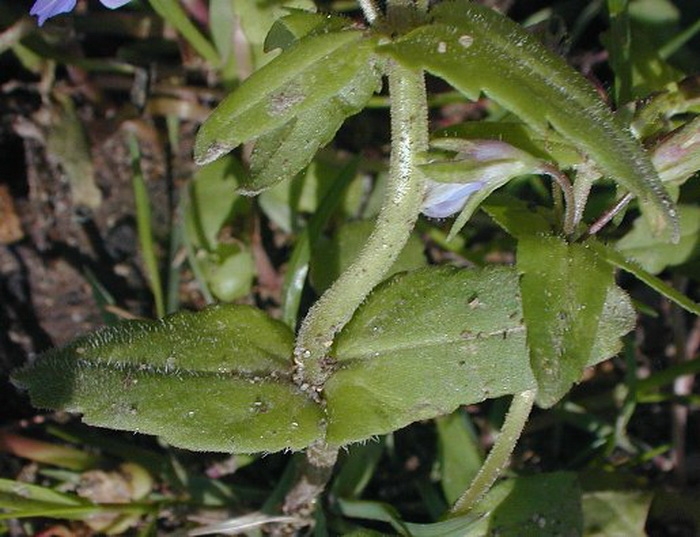
The blooming period occurs from mid- to late spring, lasting about 3 weeks. Afterwards, each flower is replaced by an globoid-ovoid capsule that contains a few large seeds. The root system consists of a slender taproot. This plant spreads by reseeding itself; it often forms colonies of variable size.
Cultivation: The preference is dappled sunlight to light shade, moist to mesic conditions, and a rich loamy soil. The size of individual plants is strongly influenced by moisture conditions and the fertility of the soil. The seeds should be planted during the summer so that they will germinate during the fall.
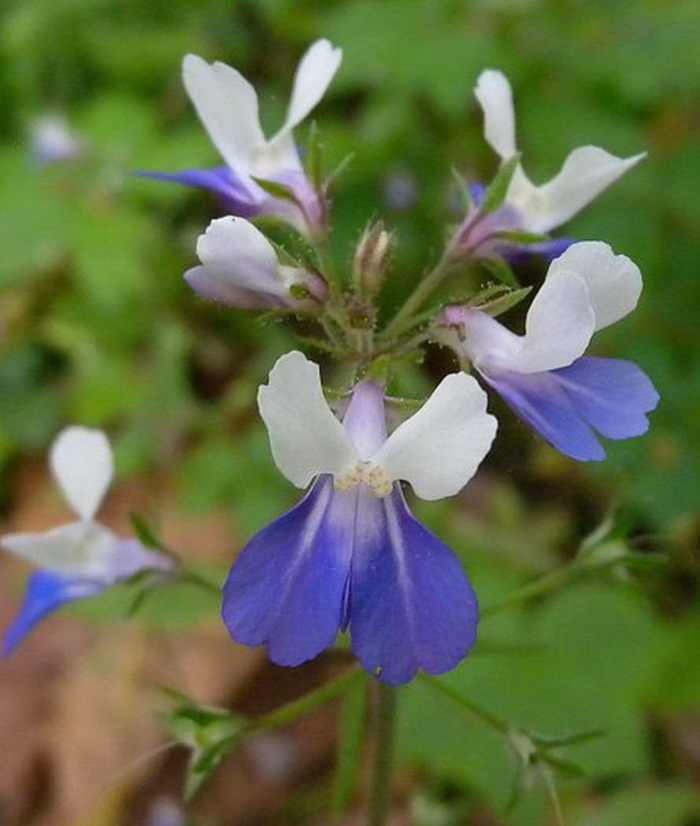
Range & Habitat: Blue-Eyed Mary occurs occasionally in NE and east central Illinois, but it tends to be less common elsewhere (see Distribution Map). At some high quality sites around the state, it is locally abundant. Habitats include moist to mesic deciduous woodlands, wooded lower slopes of river valleys, and areas along woodland paths. Sometimes Blue-Eyed Mary occurs in drier deciduous woodlands, in which case the individual plants will be smaller in size. Even though it tolerates minor levels of disturbance, this wildflower is an indicator species of high quality woodlands.
Faunal Associations: The nectar and pollen of the flowers attract honeybees, bumblebees, little carpenter bees (Ceratina spp.), long-horned bees (Synhalonia spp.), and mason bees (Osmia spp.). Less common flower visitors include dance flies (Empis spp.), the Giant Bee Fly (Bombylius major), butterflies, and skippers. Little else appears to be known about floral-faunal relationships for this species.

Photographic Location: Along a path in a deciduous woodlands at Allerton Park in Piatt County, Illinois, and the wooded lower slope of a river valley at Lodge Park in the same county.
Comments: The distinctive bicolored flowers are very beautiful, making Blue-Eyed Mary easy to identify. This woodland wildflower is unusual in having flowers that are close to a true blue color. The only other species in the genus that has been observed in Illinois is Collinsia violacea (Violet Collinsia). This latter wildflower is also a winter annual that has corollas with a deeper shade of purplish violet and more narrow lanceolate leaves. Violet Collinsia prefers sunnier habitats than Blue-Eyed Mary, and it is quite rare within the state, although more common in the Southern Plains region of the United States.
The central stem terminates in a whorl of 2-6 flowers on slender pedicels up to 1" long. Sometimes individual flowers develop from the axils of the upper leaves as well; these axillary flowers have slender pedicels up to 1½" long. The pedicels are light green, terete, and pubescent. Each flower is ½-¾" across, consisting of a green calyx with 5 teeth and a blue/white corolla. The calyx is light green to purplish green; it is often pubescent and its teeth are narrowly triangular in shape. The corolla is short-tubular and it is divided into upper and lower lips. The upper lip is cleft into 2 large rounded lobes that are white, while the lower lip is cleft into 3 lobes. The 2 large outer lobes of the lower lip are light blue to blue-violet and rounded, while the tiny middle lobe of the lower lip is folded into a keel and hidden from view. This middle lobe contains the stamens and style of the flower.

The blooming period occurs from mid- to late spring, lasting about 3 weeks. Afterwards, each flower is replaced by an globoid-ovoid capsule that contains a few large seeds. The root system consists of a slender taproot. This plant spreads by reseeding itself; it often forms colonies of variable size.
Cultivation: The preference is dappled sunlight to light shade, moist to mesic conditions, and a rich loamy soil. The size of individual plants is strongly influenced by moisture conditions and the fertility of the soil. The seeds should be planted during the summer so that they will germinate during the fall.

Range & Habitat: Blue-Eyed Mary occurs occasionally in NE and east central Illinois, but it tends to be less common elsewhere (see Distribution Map). At some high quality sites around the state, it is locally abundant. Habitats include moist to mesic deciduous woodlands, wooded lower slopes of river valleys, and areas along woodland paths. Sometimes Blue-Eyed Mary occurs in drier deciduous woodlands, in which case the individual plants will be smaller in size. Even though it tolerates minor levels of disturbance, this wildflower is an indicator species of high quality woodlands.
Faunal Associations: The nectar and pollen of the flowers attract honeybees, bumblebees, little carpenter bees (Ceratina spp.), long-horned bees (Synhalonia spp.), and mason bees (Osmia spp.). Less common flower visitors include dance flies (Empis spp.), the Giant Bee Fly (Bombylius major), butterflies, and skippers. Little else appears to be known about floral-faunal relationships for this species.

Photographic Location: Along a path in a deciduous woodlands at Allerton Park in Piatt County, Illinois, and the wooded lower slope of a river valley at Lodge Park in the same county.
Comments: The distinctive bicolored flowers are very beautiful, making Blue-Eyed Mary easy to identify. This woodland wildflower is unusual in having flowers that are close to a true blue color. The only other species in the genus that has been observed in Illinois is Collinsia violacea (Violet Collinsia). This latter wildflower is also a winter annual that has corollas with a deeper shade of purplish violet and more narrow lanceolate leaves. Violet Collinsia prefers sunnier habitats than Blue-Eyed Mary, and it is quite rare within the state, although more common in the Southern Plains region of the United States.
1
0
文章
Miss Chen
2018年05月05日

Description: This annual plant is about ½–4' tall. Medium to large plants (greater than 1½' tall) branch occasionally, while small plants (less than 1½' tall) are often unbranched. The central and lateral stems are hairless. Alternate leaves are up to 6" long and 4" across; they are ovate or deltoid-ovate with 2-4 large teeth along their margins. These teeth are pointed and widely spaced. The uppermost leaves are moreFlowering Plants narrow and may have only 0-1 teeth along their margins. The widely spreading leaves are medium to dark green and hairless; they are not white-mealy on their undersides. The leaf tips are pointed, while their bases are truncate or slightly indented. The slender petioles are up to 1" long. The central stem and upper lateral stems terminate in panicles of sessile clustered flowers. In addition to these, there are usually secondary panicles that develop from the axils of the upper leaves. The branches of these panicles can be hairless or conspicuously hairy. Individual flowers are green or greenish white and only 1/8" (3 mm.) across, consisting of 5 sepals, 5 stamens, and a flattened ovary with a pair of tiny styles at its apex. There are no petals. The sepals are ovate and slightly keeled. The blooming period can occur from late spring into the fall. On an individual plant in bloom, the flowers are at different stages of development. Pollination is by wind. The persistent sepals only partially cover the developing seeds; there is only one seed per flower. Each seed is covered with a thin membrane that is easily removed. Individual seeds are flattened, circular in circumference, and shiny black; they are 1.5–2.0 mm. across. The root system consists of a taproot. This plant spreads into new areas by reseeding itself.
Cultivation: The preference is dappled sunlight to medium shade and mesic to dry conditions. While this plant is usually found on rocky ground, it will adapt to ordinary garden soil. Depending on the fertility of the soil and moisture conditions, the size of individual plants can vary considerably.
Range & Habitat: Maple-Leaved Goosefoot is uncommon to occasional in most areas of Illinois, except in the east-central section of the state, where it is rare or absent (see Distribution Map). This is a native plant. Habitats include rocky upland woodlands, shaded or semi-shaded ledges of cliffs, bottoms of thinly wooded bluffs, recently logged or burned woodlands, woodland openings, shaded to semi-shaded areas of rocky glades, thickets, and fence rows. Maple-Leaved Goosefoot is often found in high quality habitats, but it also occurs in disturbed areas. This is one of the less weedy Chenopodium spp.
Faunal Associations: Little is known about floral-faunal relationships for this unusual woodland plant, although several moths, skippers, and leaf beetles are known to feed on Chenopodium spp. primarily in weedy open areas. The Bobwhite and several sparrows eat the seeds of these species, while White-Tailed Deer occasionally browse on the foliage.

Photographic Location: Ledge of a sandstone cliff at the Portland Arch in west-central Indiana.
Comments: Maple-Leaved Goosefoot (Chenopodium simplex) has very distinctive leaves, which makes it is easy to recognize. These leaves are usually larger in size than those of many other Chenopodium spp., and they usually have 1-4 pairs of widely spaced large teeth. Other Chenopodium spp. have leaves with smaller teeth or their leaves lack teeth altogether. Unlike Maple-Leaved Goosefoot, these latter species often have white-mealy leaf undersides, white-mealy upper stems, and/or white-mealy sepals. They are usually found in sunny disturbed areas rather than woodlands. The American species, Maple-Leaved Goosefoot (Chenopodium simplex), closely resembles a European species with the same common name, Chenopodium hybridum (Maple-Leaved Goosefoot), but it has a different number of chromosomes. The American species is sometimes referred to as Chenopodium gigantospermum, which refers to its relatively large seeds for species in this genus.
Cultivation: The preference is dappled sunlight to medium shade and mesic to dry conditions. While this plant is usually found on rocky ground, it will adapt to ordinary garden soil. Depending on the fertility of the soil and moisture conditions, the size of individual plants can vary considerably.
Range & Habitat: Maple-Leaved Goosefoot is uncommon to occasional in most areas of Illinois, except in the east-central section of the state, where it is rare or absent (see Distribution Map). This is a native plant. Habitats include rocky upland woodlands, shaded or semi-shaded ledges of cliffs, bottoms of thinly wooded bluffs, recently logged or burned woodlands, woodland openings, shaded to semi-shaded areas of rocky glades, thickets, and fence rows. Maple-Leaved Goosefoot is often found in high quality habitats, but it also occurs in disturbed areas. This is one of the less weedy Chenopodium spp.
Faunal Associations: Little is known about floral-faunal relationships for this unusual woodland plant, although several moths, skippers, and leaf beetles are known to feed on Chenopodium spp. primarily in weedy open areas. The Bobwhite and several sparrows eat the seeds of these species, while White-Tailed Deer occasionally browse on the foliage.

Photographic Location: Ledge of a sandstone cliff at the Portland Arch in west-central Indiana.
Comments: Maple-Leaved Goosefoot (Chenopodium simplex) has very distinctive leaves, which makes it is easy to recognize. These leaves are usually larger in size than those of many other Chenopodium spp., and they usually have 1-4 pairs of widely spaced large teeth. Other Chenopodium spp. have leaves with smaller teeth or their leaves lack teeth altogether. Unlike Maple-Leaved Goosefoot, these latter species often have white-mealy leaf undersides, white-mealy upper stems, and/or white-mealy sepals. They are usually found in sunny disturbed areas rather than woodlands. The American species, Maple-Leaved Goosefoot (Chenopodium simplex), closely resembles a European species with the same common name, Chenopodium hybridum (Maple-Leaved Goosefoot), but it has a different number of chromosomes. The American species is sometimes referred to as Chenopodium gigantospermum, which refers to its relatively large seeds for species in this genus.
0
0
文章
Miss Chen
2018年05月04日

Description: This perennial wildflower is 4-12" tall and unbranched, except for possibly 1-2 flowering side stems near the apex. The erect central stem is light green to purplish green, terete, and hairy. At the base of each plant, 1-2 basal leaves are commonly present; they are about 1" long and across,Close-up of Flowers cordate-orbicular, and bluntly dentate or undulate along their margins. Each basal leaf has a long slender petiole. The alternate leaves are up to 2" long and 1" across; they are oval-ovate to oblong, bluntly dentate or undulate along the margins, and ciliate. At the base, the alternate leaves are sessile or slightly clasp the central stem. The alternate leaves become slightly shorter and more narrow as they ascend the stem. The central stem terminates in a raceme of flowers. The flowers and buds are concentrated toward the apex of the raceme, while cylindrical seedpods (siliques) develop along the remainder of the raceme. Each flower is about ½–¾" across, consisting of 4 petals, 4 sepals, several stamens, and a single stout style of the pistil. The petals are pale purple or purple-tinted white and obovate in shape. The sepals are purple, hairy, and membranous-white along their margins. The petals are much longer than the sepals. The blooming occurs during mid-spring and lasts about 2 weeks. The flowers are fragrant. Each flower is replaced by an ascending silique up to 1" long. The 2-valved siliques are green to purple; each silique contains a single row of seeds and it has a stout pedicel up to 1" long at its base. Eventually, the silique splits in half lengthwise to release the seeds. The root system is fibrous and tuberous.
Cultivation: This wildflower develops early during the spring when it receives dappled sunlight from its location underneath deciduous trees. It likes an evenly moist site with fertile loamy soil and abundant leaf mold. By the beginning of summer, it has already died down and released its seeds.
Range & Habitat: The native Purple Cress is occasional in NE and east central Illinois, but it is rare or absent elsewhere in the state (see Distribution Map). Habitats include moist deciduous woodlands, low wooded valleys, and areas along shaded seeps and springs, particularly where limestone comes close to the surface of the ground. This conservative species is normally found where the original ground flora is still intact. It is one of the spring wildflowers in woodlands that is threatened by the spread of Alliaria petiolata (Garlic Mustard).

Faunal Associations: Records about floral-faunal relationships for this species are limited. Insect visitors of the flowers are probably similar to those of a closely related species, Cardamine bulbosa (Spring Cress), which blooms only a little latter and occupies similar habitats. These insects include various kinds of bees (honeybees, mason bees, Andrenid bees, Halictid bees), bee flies (including Bombylius major, the Giant Bee Fly), other miscellaneous flies, and butterflies that appear during the spring. Most of these insects suck nectar from flowers, although some of the bees and flies also seek pollen. An oligolectic flea beetle that prefers woodland habitats, Phyllotreta bipustulata, feeds on the foliage of Purple Cress; it also feeds on the foliage of Dentaria spp. (Toothworts). Mammalian herbivores rarely feed on this wildflower because its foliage is short-lived and unpleasant-tasting (bitter and spicy).
Photographic Location: Along a shaded seep in Vermilion County, Illinois.
Comments: This is another lovely spring wildflower of the woodlands. Purple Cress is similar to Cardamine bulbosa (Spring Cress), except that the latter has flowers with white petals and green sepals. Spring Cress also has a glabrous central stem, while Purple Cress has a hairy stem. In contrast to Dentaria spp. (Toothworts) and many other Cardamine spp. (Bitter Cress species), both of these wildflowers lack compound leaves that are pinnately or palmately divided. Another species of the Mustard family, Iodanthus pinnatifidus (Purple Rocket), produces pale purple flowers on long racemes in damp wooded areas. However, Purple Rocket is a larger plant that blooms later in the year (late spring to mid-summer). Other common names of Cardamine douglassii are Purple Spring Cress and Northern Bitter Cress.
Cultivation: This wildflower develops early during the spring when it receives dappled sunlight from its location underneath deciduous trees. It likes an evenly moist site with fertile loamy soil and abundant leaf mold. By the beginning of summer, it has already died down and released its seeds.
Range & Habitat: The native Purple Cress is occasional in NE and east central Illinois, but it is rare or absent elsewhere in the state (see Distribution Map). Habitats include moist deciduous woodlands, low wooded valleys, and areas along shaded seeps and springs, particularly where limestone comes close to the surface of the ground. This conservative species is normally found where the original ground flora is still intact. It is one of the spring wildflowers in woodlands that is threatened by the spread of Alliaria petiolata (Garlic Mustard).

Faunal Associations: Records about floral-faunal relationships for this species are limited. Insect visitors of the flowers are probably similar to those of a closely related species, Cardamine bulbosa (Spring Cress), which blooms only a little latter and occupies similar habitats. These insects include various kinds of bees (honeybees, mason bees, Andrenid bees, Halictid bees), bee flies (including Bombylius major, the Giant Bee Fly), other miscellaneous flies, and butterflies that appear during the spring. Most of these insects suck nectar from flowers, although some of the bees and flies also seek pollen. An oligolectic flea beetle that prefers woodland habitats, Phyllotreta bipustulata, feeds on the foliage of Purple Cress; it also feeds on the foliage of Dentaria spp. (Toothworts). Mammalian herbivores rarely feed on this wildflower because its foliage is short-lived and unpleasant-tasting (bitter and spicy).
Photographic Location: Along a shaded seep in Vermilion County, Illinois.
Comments: This is another lovely spring wildflower of the woodlands. Purple Cress is similar to Cardamine bulbosa (Spring Cress), except that the latter has flowers with white petals and green sepals. Spring Cress also has a glabrous central stem, while Purple Cress has a hairy stem. In contrast to Dentaria spp. (Toothworts) and many other Cardamine spp. (Bitter Cress species), both of these wildflowers lack compound leaves that are pinnately or palmately divided. Another species of the Mustard family, Iodanthus pinnatifidus (Purple Rocket), produces pale purple flowers on long racemes in damp wooded areas. However, Purple Rocket is a larger plant that blooms later in the year (late spring to mid-summer). Other common names of Cardamine douglassii are Purple Spring Cress and Northern Bitter Cress.
0
0
文章
Miss Chen
2018年05月04日

Description: This annual plant consists of sprawling stems with pairs of opposite leaves. The stems are up to 5 cm. (2") long; they are whitish green and occasionally branch. The opposite leaves are 3-4 mm. long and about half as much across; they are medium green, ovate-oblong or obovate-oblong, and smooth along their margins. Each leaf tapers to a short petiole. There are separate male and female flowers on each plant (monoecious) at the axils of the leaves. These flowers are very small (less than 1/8" across) and greenish. Each male flower produces a single stamen, while each female flowers produces a single pistil with a pair of styles. These flowers have neither petals nor sepals. The blooming period occurs from late spring to mid-summer and lasts 1-2 months. The fruit of each female flower is 4-celled; it has a double-ovoid shape (similar to the fruit of a Galium sp.) and a short peduncle. Each cell of the fruit contains a single nutlet. This plant reproduces primarily by reseeding itself; it can reproduce vegetatively by forming rootlets at the axils of the leaves.
Cultivation: The preference is light shade to dappled sunlight, moist to dry-mesic conditions, and barren soil that is devoid of competing ground vegetation. This plant is often found on compacted soil containing clay, glacial till, or rocky material.
Range & Habitat: The native Terrestrial Starwort occurs occasionally in the southern half of Illinois; it is largely absent in the northern half of the state (see Distribution Map). Habitats include barren areas of hilly upland woodlands (particularly those that are dominated by oaks), edges of bluffs, footpaths in wooded areas, shaded gravelly seeps, and rocky riverbanks.
Faunal Associations: Information about floral-faunal relationships for this species is unavailable.

Photographic Location: Along a bluff in Vermilion County, Illinois.
Comments: This is probably the smallest terrestrial flowering plant in Illinois (Lemma minor, or Lesser Pondweed, is even smaller, but it floats on water). To see the flowers and fruits near the axils of the leaves, a 10x hand lens is required. Terrestrial Starwort resembles a low-growing moss, but it is more leafy in appearance. Other species in this genus are submerged or emergent aquatic plants; these Callitriche spp. are referred to as Water Starworts, and they are small in size as well. The submerged leaves of these latter species are linear in shape, but their emergent leaves resemble those of Terrestrial Starwort. While the fruits of Terrestrial Starwort have short peduncles, the fruits of Water Starworts are sessile, or nearly so.
Cultivation: The preference is light shade to dappled sunlight, moist to dry-mesic conditions, and barren soil that is devoid of competing ground vegetation. This plant is often found on compacted soil containing clay, glacial till, or rocky material.
Range & Habitat: The native Terrestrial Starwort occurs occasionally in the southern half of Illinois; it is largely absent in the northern half of the state (see Distribution Map). Habitats include barren areas of hilly upland woodlands (particularly those that are dominated by oaks), edges of bluffs, footpaths in wooded areas, shaded gravelly seeps, and rocky riverbanks.
Faunal Associations: Information about floral-faunal relationships for this species is unavailable.

Photographic Location: Along a bluff in Vermilion County, Illinois.
Comments: This is probably the smallest terrestrial flowering plant in Illinois (Lemma minor, or Lesser Pondweed, is even smaller, but it floats on water). To see the flowers and fruits near the axils of the leaves, a 10x hand lens is required. Terrestrial Starwort resembles a low-growing moss, but it is more leafy in appearance. Other species in this genus are submerged or emergent aquatic plants; these Callitriche spp. are referred to as Water Starworts, and they are small in size as well. The submerged leaves of these latter species are linear in shape, but their emergent leaves resemble those of Terrestrial Starwort. While the fruits of Terrestrial Starwort have short peduncles, the fruits of Water Starworts are sessile, or nearly so.
0
0
文章
Miss Chen
2018年05月03日

Description: This perennial plant is about 2-3' tall, branching occasionally. This member of the Nettle family lacks stinging hairs. The stems are light green, 4-angled or round, and glabrous or slightly pubescent. The leaves are usually opposite along the stems, but sometimes they are alternate. They are ovate or ovate-lanceolate, up to 4" long and 2½" across, and have long slender petioles. The upper surface of each leaf is dark green (in the shade) and glabrous or slightly pubescent; a central vein and 2 parallel secondary veins are readily observable. The margins are coarsely serrated. Spikes of green or greenish white flowers appear from the axils of the upper leaves. They are straight and angle upward from the axis of the central stem. The flowering spikes are about ½–3" long; sometimes they are terminal, but more often they will develop additional leaves beyond the flowers. False Nettle is usually dioecious, with male and female flowers produced on separate plants. Male flowers are distributed along the spikes in bunches, while female flowers are produced along the spikes more or less continuously. These flowers are very small and lack petals. Each male flower has a 4-parted calyx and 4 stamens, while the calyx of the female flower is tubular with 2-4 teeth. The blooming period is mid-summer to early fall, and lasts about 1-2 months. There is no floral scent; pollination is by wind. The fruit consists of a small achene. This description applies to the typical woodland variety of False Nettle, Boehmeria cylindrica cylindrica. The other variety of False Nettle, Boehmeria cylindrica drummondiana, grows in the sun and has a somewhat different appearance.

Cultivation: The preference is light shade, moist conditions, and rich loamy soil. In sunnier locations, this plant prefers wetter ground and the foliage may become yellowish green.
Range & Habitat: The native False Nettle is a common plant that occurs in most counties of Illinois (see Distribution Map). Habitats include wet to mesic deciduous woodlands, especially in floodplain and bottomland areas, as well as various wetlands, including swamps, low areas along rivers, borders of small streams, seeps, and sandy marshes. False Nettle can be found in both degraded and higher quality habitats.
Faunal Associations: The flowers don't attact many insects because they are wind-pollinated. Caterpillars of the butterflies Polygonia comma (Comma), Polygonia interrogationis (Question Mark), and Vanessa atalanta (Red Admiral) feed on the foliage of False Nettle; caterpillars of the moth Bomolocha manalis (Flowing-Line Bomolocha) also feed on this plant (Wagner, 2005; Bouseman & Sternburg, 2001). Larvae of a fly, Neolasioptera boehmeriae, form spindle-shaped galls on the stems. Because the foliage lacks stinging hairs and it is non-toxic, mammalian herbivores probably browse on this plant occasionally.
Photographic Location: Along a woodland path at Busey Woods in Urbana, Illinois.
Comments: Sometimes people instinctively shy away from this plant thinking that it has stinging hairs – in fact, this is not the case, hence the common name. In Illinois, the two members of the Nettle family with stinging hairs are Laportea canadensis (Wood Nettle) and Urtica dioica (Stinging Nettle). The latter species has been introduced from Europe. The other common member of the Nettle family without stinging hairs, Pilea pumila (Clearweed), is a hairless annual plant with translucent stems and shiny leaves. Clearweed has terminal flowering spikes that are usually shorter than the petioles of the leaves, while the flowering spikes of False Nettle are usually longer than the petioles, and leaves are often produced beyond the flowers.

Cultivation: The preference is light shade, moist conditions, and rich loamy soil. In sunnier locations, this plant prefers wetter ground and the foliage may become yellowish green.
Range & Habitat: The native False Nettle is a common plant that occurs in most counties of Illinois (see Distribution Map). Habitats include wet to mesic deciduous woodlands, especially in floodplain and bottomland areas, as well as various wetlands, including swamps, low areas along rivers, borders of small streams, seeps, and sandy marshes. False Nettle can be found in both degraded and higher quality habitats.
Faunal Associations: The flowers don't attact many insects because they are wind-pollinated. Caterpillars of the butterflies Polygonia comma (Comma), Polygonia interrogationis (Question Mark), and Vanessa atalanta (Red Admiral) feed on the foliage of False Nettle; caterpillars of the moth Bomolocha manalis (Flowing-Line Bomolocha) also feed on this plant (Wagner, 2005; Bouseman & Sternburg, 2001). Larvae of a fly, Neolasioptera boehmeriae, form spindle-shaped galls on the stems. Because the foliage lacks stinging hairs and it is non-toxic, mammalian herbivores probably browse on this plant occasionally.
Photographic Location: Along a woodland path at Busey Woods in Urbana, Illinois.
Comments: Sometimes people instinctively shy away from this plant thinking that it has stinging hairs – in fact, this is not the case, hence the common name. In Illinois, the two members of the Nettle family with stinging hairs are Laportea canadensis (Wood Nettle) and Urtica dioica (Stinging Nettle). The latter species has been introduced from Europe. The other common member of the Nettle family without stinging hairs, Pilea pumila (Clearweed), is a hairless annual plant with translucent stems and shiny leaves. Clearweed has terminal flowering spikes that are usually shorter than the petioles of the leaves, while the flowering spikes of False Nettle are usually longer than the petioles, and leaves are often produced beyond the flowers.
0
0
文章
Miss Chen
2018年05月03日

Description: This perennial plant is 1-3' tall and unbranched or sparingly branched. The central stem is light to dark green, 4-angled, and covered with long white hairs. The opposite leaves are up to 3½" long and 1½" across. They are ovate or lanceolate-ovate in shape, serrated along their margins, and often ciliate. The lower surface of each leaf is light to medium green and densely pubescent to nearly glabrous; in the latter case, there are scattered hairs along the central and some of the lateral veins. The upper leaf surface is medium to dark green; it has either scattered appressed hairs or it is glabrous. The petioles are about ½-1¼" long and covered with spreading hairs. Small secondary leaves often develop from the axils of the leaves on the central stem.
The central stem (and any major side stems) terminates in several whorls of flowers. The whorls of flowers occur above the axils of the upper leaves, or they may occur above pairs of leafy bracts that are sometimes inconspicuous. The flowers in each whorl are densely crowded together. Each flower is up to ½" long, consisting of a short-tubular calyx with 5 teeth, a 2-lipped corolla, 2 exerted stamens, and a slender style that is divided at its tip. The calyx is light green and exceedingly hairy along the margins of its teeth; the upper teeth are longer than the lower teeth. The corolla is light purple or white and it has purple dots on the lower lip; the outer surface of this corolla is finely pubescent on the upper side. The lower lip is divided into 3 lobes, while the upper lip functions as a protective hood. The blooming period occurs during the summer and lasts about 1-1½ months. Each flower is replaced by 4 ovoid nutlets. The root system is fibrous and rhizomatous. Clonal colonies of plants often develop from the rhizomes.

Cultivation: The preference is partial sun to light shade, moist to mesic conditions, and a rich loamy soil with decaying leaf mold. This species also grows in soil that is somewhat rocky.
Range & Habitat: The native Hairy Wood Mint occurs occasionally throughout Illinois (see Distribution Map). Habitats include mesic deciduous woodlands, areas along woodland paths, woodland borders, woodland openings, limestone glades, and thickets. Minor disturbance is desirable if it removes excessive shade from the overhead canopy.

Faunal Associations: The flowers are pollinated primarily by long-tongued bees, including honeybees, bumblebees, little carpenter bees (Ceratina spp.), mason bees (Osmia spp.), leaf-cutting bees (Megachile spp.), cuckoo bees (Epeolus spp.), long-horned bees (Melissodes spp.), and Anthophorid bees (Anthophora spp.). Other visitors of the flowers include Halictid bees, wasps, bee flies (Bombyliidae), thick-headed flies (Conopidae), Syrphid flies, butterflies, and skippers. These insects seek nectar primarily, although some of the Halictid bees collect pollen and some flies feed on the pollen. There are few records of insects feeding destructively on Hairy Wood Mint, although a polyphagous aphid, Aphis coreopsidis, uses this plant as a summer host. The foliage probably isn't attractive to mammalian herbivores as a food source.

Photographic Location: Along a woodland path at Busey Woods in Urbana, Illinois.
Comments: This is another member of the Mint family with pairs of opposite leaves and relatively small tubular flowers. Hairy Wood Mint (Blephilia hirsuta) has unusually hairy stems and the dense hairy whorls of flowers are rather conspicuous. These dense whorls of flowers distinguish the genus Blephilia from many other members of the Mint family. The only other member of this genus that occurs in Illinois is Downy Wood Mint (Blephilia ciliata). Downy Wood Mint has leaves that are sessile or they have short petioles (less than ½"), and its stems are short-pubescent to pubescent. Hairy Wood Mint, on the other hand, has leaves with longer petioles and its stems have spreading white hairs that are quite long. Downy Wood Mint prefers habitats that are somewhat sunnier and drier; it is sometimes found in prairies and savannas.
The central stem (and any major side stems) terminates in several whorls of flowers. The whorls of flowers occur above the axils of the upper leaves, or they may occur above pairs of leafy bracts that are sometimes inconspicuous. The flowers in each whorl are densely crowded together. Each flower is up to ½" long, consisting of a short-tubular calyx with 5 teeth, a 2-lipped corolla, 2 exerted stamens, and a slender style that is divided at its tip. The calyx is light green and exceedingly hairy along the margins of its teeth; the upper teeth are longer than the lower teeth. The corolla is light purple or white and it has purple dots on the lower lip; the outer surface of this corolla is finely pubescent on the upper side. The lower lip is divided into 3 lobes, while the upper lip functions as a protective hood. The blooming period occurs during the summer and lasts about 1-1½ months. Each flower is replaced by 4 ovoid nutlets. The root system is fibrous and rhizomatous. Clonal colonies of plants often develop from the rhizomes.

Cultivation: The preference is partial sun to light shade, moist to mesic conditions, and a rich loamy soil with decaying leaf mold. This species also grows in soil that is somewhat rocky.
Range & Habitat: The native Hairy Wood Mint occurs occasionally throughout Illinois (see Distribution Map). Habitats include mesic deciduous woodlands, areas along woodland paths, woodland borders, woodland openings, limestone glades, and thickets. Minor disturbance is desirable if it removes excessive shade from the overhead canopy.

Faunal Associations: The flowers are pollinated primarily by long-tongued bees, including honeybees, bumblebees, little carpenter bees (Ceratina spp.), mason bees (Osmia spp.), leaf-cutting bees (Megachile spp.), cuckoo bees (Epeolus spp.), long-horned bees (Melissodes spp.), and Anthophorid bees (Anthophora spp.). Other visitors of the flowers include Halictid bees, wasps, bee flies (Bombyliidae), thick-headed flies (Conopidae), Syrphid flies, butterflies, and skippers. These insects seek nectar primarily, although some of the Halictid bees collect pollen and some flies feed on the pollen. There are few records of insects feeding destructively on Hairy Wood Mint, although a polyphagous aphid, Aphis coreopsidis, uses this plant as a summer host. The foliage probably isn't attractive to mammalian herbivores as a food source.

Photographic Location: Along a woodland path at Busey Woods in Urbana, Illinois.
Comments: This is another member of the Mint family with pairs of opposite leaves and relatively small tubular flowers. Hairy Wood Mint (Blephilia hirsuta) has unusually hairy stems and the dense hairy whorls of flowers are rather conspicuous. These dense whorls of flowers distinguish the genus Blephilia from many other members of the Mint family. The only other member of this genus that occurs in Illinois is Downy Wood Mint (Blephilia ciliata). Downy Wood Mint has leaves that are sessile or they have short petioles (less than ½"), and its stems are short-pubescent to pubescent. Hairy Wood Mint, on the other hand, has leaves with longer petioles and its stems have spreading white hairs that are quite long. Downy Wood Mint prefers habitats that are somewhat sunnier and drier; it is sometimes found in prairies and savannas.
0
0





